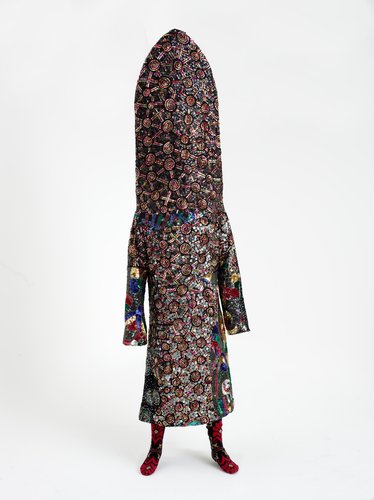John Hurrell – 21 March, 2019
One minute the forms seem connected to Papunya Tula painting, then to Melanesian dance costumes, then Roman Catholic ecclesiastic garments, then Frank Stella, then Japanese woodcuts, then William Morris, then Matisse, then Miriam Shapiro, then Sam Gilliam—and so on. The mercurial changing of design and art historical references goes on and on. It's truly protean. If it weren't so engrossing it would be exhausting.
Displayed as a new acquisition on the bottom floor next to the entrance—for a short period of a few days so that contributors to an acquisition fund could enjoy it—this extraordinary, visually lavish garment (on a mannequin) was made in response to the much publicised video of the Rodney King beating at the hands of Los Angeles police officers (1991).
Created by Nick Cave the African-American fabric sculptor (not the Australian rock musician), this tall, faceless, skirted suit—that ironically alludes to the hooded sheets of the KKK—is densely packed with glittering decorative motifs (made with thousands of sequins, buttons, staples, pins and beads that rustle when moved) that seem truly transnational in their hybridity. Loaded with super-subtle colour, intricate texture and surprising geographic allusion, combined with those bits that ominously rattle, Cave’s strangely tactile ‘American’ sculpture encourages prolonged looking.
Cave‘s work is akin to that (in Aotearoa) of Reuben Paterson, but compositionally, miles more complicated. The merged design sections keep shifting as your eyes move over the garment’s surfaces, taking in the artist’s exuberant eclecticism that with comma (scare-quote) shapes references its own making process.
One minute the forms seem connected to Papunya Tula painting, then to Melanesian dance costumes, then Roman Catholic ecclesiastic garments, then Frank Stella, then Japanese woodcuts, then William Morris, then Matisse, then Miriam Shapiro, then Sam Gilliam—and so on. The mercurial changing of design and art historical references goes on and on. It’s truly protean. If it weren’t so engrossing it would be exhausting.
Cave seems to regard this item as a protective cloak, thwarting racially motivated violence by exuberantly muddling identity, making the wearer’s race, gender, sexuality, or class safely hidden and invisible. It is an exterior that is a decoy that confuses any enemy, a distraction that celebrates visual diversity while flummoxing any aggressor, a garment so wildly conspicuous it obliterates any awareness or memory of its wearer.
John Hurrell








 Advertising in this column
Advertising in this column Two Rooms presents a program of residencies and projects
Two Rooms presents a program of residencies and projects



This Discussion has 0 comments.
Comment
Participate
Register to Participate.
Sign in
Sign in to an existing account.